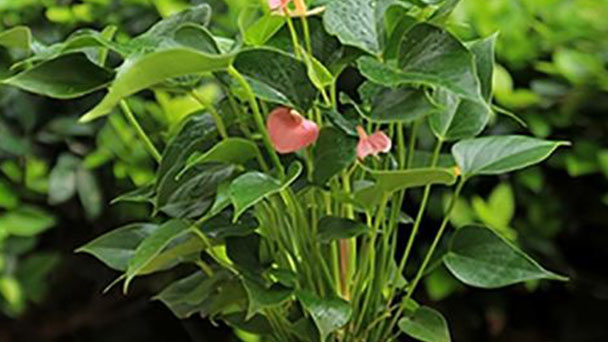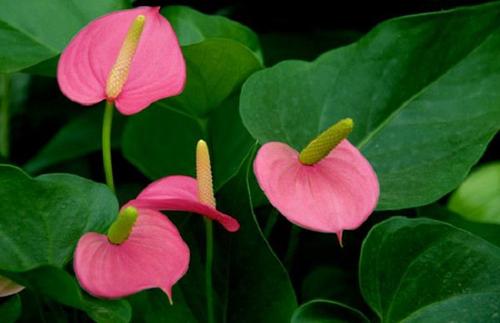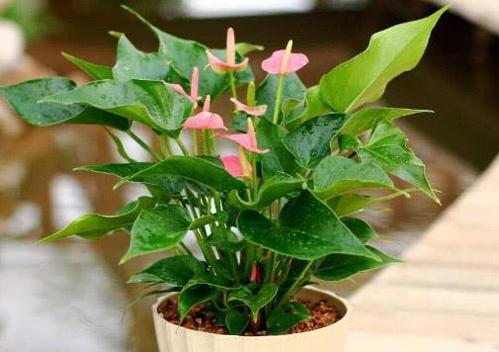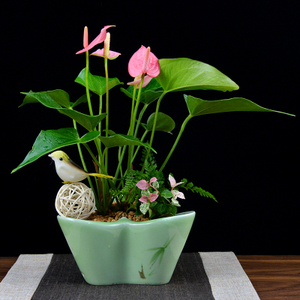Flamingo flower (painter's palette) profile
Written by Maggie
Sep 09 2021

Flamingo Flower, the scientific name Anthurium andraeanum, also known as painter's palette, Flamingo lily, tail flower, is a perennial evergreen herb of the Araceae family. Flamingo flowers can be grown on the ground. Hydroponics is about avoiding the sun and seeing it once a month is good. Flamingo Flower likes warm and humid and good drainage environment, afraid of drought and strong light exposure.
Flamingo flower has unique flowers, bright and gorgeous spaces, rich colors, highly variable flowers, and a long flowering period, which can last 2-4 months in hydroponic culture. The Flamingo flower is a famous and excellent flower with great development prospects.
Flamingo flowers bloom all year round.
Flamingo flowers picture

Morphological characteristics of flamingo flowers
Flamingo flowers are perennial epiphytic evergreen herbs. Plant height is up to 1 m, short internodes. Leaves extracted from the rhizome, long stalk, solitary, oblong cordate or ovoid, dark bright green, shiny. Flower buds from leaf axils, spathe upright spread, leathery, oblong-ovoid, pink or scarlet.
Flamingo Flower varieties are milky white, inlaid white and green, five colors and seven fine red edge varieties, very varied. Pinnacle is sessile, terete, erect, slightly decumbent. Flowers are bisexual, perianth with four lobes, stamens 4, ovary 2 locules, 1 -- 2 ovules in each locule. Small berries are with 2-4 seeds, pink, dense on spikelets.
Flamingo flowers are perennial evergreen herbs with plant heights ranging from 50 cm to 80cm, depending on the species. Roots are fleshy, caultless, leaves drawn from the rhizome, long stalk, solitary, cordate, bright green, veins concave. Flowers are axillary, spathose-waxy, orbicular to ovoid, bright red or orange-red fleshy, white, spikelet, terete, erect.
Flamingo flowers bloom all year round.
Flamingo flower ecology
Flamingo flowers are native to the tropical rain forests of southwest Colombia in South America, South America, Africa, Europe and Asia, where it is hot and humid all the year-round, where the sunlight is sparse and the hummus is loose and rich, which determines the growth habits of Flamingo flowers.
Flamingo flowers like hot, humid, well-drained environments and are afraid of drought and strong sunlight. The optimum temperature for its growth is 26 ~ 32℃ at day and 21 ~ 32℃ at night. The highest temperature that can be tolerated is 35℃, and the lowest temperature that can be tolerated is 14℃. The light intensity is 16000 ~ 2000LX, and the relative humidity (RH) is 70% ~ 80%.
Flamingo flowers like high air humidity and fluid drainage. They like shade and heat. When the temperature is not higher than 28℃ in the daytime and 20℃ at night, plants can blossom and bear fruit all year round. If the temperature is higher than 35℃, sunburn will occur; if it is lower than 14℃, growth will be affected; if it is lower than 0℃, plants will freeze to death. The air humidity should reach 80%, the soil pH value should be 5.5, and the EC value should be 1.2. Flamingo Flower requires loose soil, fertile, had better carry on soilless cultivation.
Flamingo flowers like warm, humid, semi-cloudy environments and avoid direct sunlight.
How to grow and care for flamingo flower
Flamingo flowers can be grown in pots or hydroponics. No matter how they are grown, Flamingo flowers have a soft, comfortable feel and can be used for decoration at home.
Soil
Flamingo flowers should be cultivated in loose, breathable, water-permeable soil that can maintain water and fertilizer. The best soil contains certain nutrients. You can choose leaf sapling soil or peat soil with some perlite or coal sand residue and base fertilizer to form vegetative soil. Some broken bricks can be added to the floor of the basin to facilitate drainage.
Watering
Flamingo flowers like moisture and do not like drought. They should keep the soil moist frequently. Water in the summer as much as the soil is dry or wet, maybe once or twice a day. Moisture with slight acid is the best, can choose the pH value of water between 4.5-5. Flamingo Flower should also be sprayed with water during the dry season.
Light
Flamingo flowers are shade plants. They are best placed in shaded areas, but they should not be completely out of contact with light because they lack color and they should be shaded in the sun so that they are not fully exposed to the sun. But when the sun is weaker in winter, there is no need to keep out, and you can rest assured to put it under the sun.
Temperature
Flamingo flowers like warmth and fear the cold, so they should be protected against high temperatures in the summer and against freezing in the winter. Suitable growth temperature is 19-25 degrees, below 13 degrees, the plant into the dormant period should be put into the house or wrapped with plastic bags, to prevent freezing damage. When the temperature is higher than 32 degrees, Flamingo Flower will stop growing. Generally, when the temperature is higher than 25 degrees, it is necessary to open windows and ventilate to alleviate the adverse effects of high temperatures.
Fertilization
Fertilizer could promote Flamingo flower growth, fertilization, when liquid fertilizer can be selected or select the NPK ratio, is: compound fertilizer, about once every 7 to 12 days of fertilization, fertilization had better in the morning or evening, the effect will be better, or regular fertilization, water is in the water with a drop or two of liquid fertilizer in the water, and water, usually once every three days, but can only choose a fertilization way, cannot be used.
Repotting
These indoor plants will want to be repotted during spring on a two-year cycle or when they become pot-bound. Propagation can take place then by merely dividing the plant’s root system and replanting in a soil mix with equal parts potting soil and perlite or orchid soil mix.
Cleaning
To dust or clean the leaves, put the plant in a shower every couple months, and fill a watering can with filtered water, and rinse the leaves. Groom this indoor plant regularly by removing any discolored or dying leaves or fading flowers. Remove the old blooms, all the way down to the base to encourage new blooms. Spritz both sides of the leaves to ensure it gets adequate humidity.
Common Issues of flamingo flower
Excess light will bleach the leaves and may produce browning tips.
Overfertilization will develop browning tips and yellow leaves on the lower leaves.
Lack of flowers may indicate it needs repotting, or it’s not getting enough light or phosphorus in the fertilizer.

Flamingo Flower - Most Common House Plant
Flamingo flower toxicity
Flamingo flowers are actually toxic because of the mucus that is secreted after the stems and leaves are broken. There are two main components in them. One is calcium oxalate, which is slightly irritating to the skin, and the other is hydrolyzed protein, which a few people are allergic to.
It's not that it's poisonous because it's poisonous, it's that Flamingo flowers contain toxic chemicals, so as long as you don't eat them, you don't get toxic. Flamingo flowers also suck up benzene and trichloroethylene from the air, so they clean the air and they're good to keep. Just be careful not to touch it with your bare skin too often and don't ingest it by mistake. As to the gas that normal transpiration action secretes is completely avirulent, can be at ease breed, put the bedroom to have nothing to do with.
Flamingo flower hydroponic method
Flamingo flowers are plants in the Araceae family, which are very hydrophilic plants. But hydroponics is much more difficult than Chlorophyllum and Chlorophyllum.
Flamingo flowers have very strong root breathing and entering the water can easily prevent them from breathing. The best way to do this is to use a substrate, and the best substrate is ceramsite. Since Flamingo flowers have fleshy roots and the leaves are pulled from the roots, the custom blue + stone + easy method is not easy to produce leaflets. And ceramsite texture is light, space is sufficient, easy to make the leaflet out.
Flamingo flowers in terracotta hydroponics are made by first washing the roots, pruning the old roots, roots, and removing the flowers. Then place the plants in containers. Fill with ceramsite, and then dilute the root powder in proportion, spray wet ceramsite, pay attention to not too much water below, if the water is too much to pour away. After a long wait, the thick white roots of a Flamingo flower grow on all sides, close to the edges of the container, and the next thing to do is to regularly add a nutrient solution to help them grow.
Culture considerations for hydroponic Flamingo flowers
Flamingo flowers that have just been hydroponic with ceramsite are not easily exposed to direct sunlight and can be stored in the shade.
Just start hydroponics do not add nutrition liquid, add root powder is best.
Flamingo flower containers are slightly larger, preferably wide at the top and narrow at the bottom, V-shaped and of a certain height.
If you want to do pure hydroponic Flamingo flowers, it is recommended to transfer to pure hydroponic culture after induction with ceramsite. Direct entry into the water is not recommended.
Flamingo flowers propagation
Flamingo flowers are often propagated by branching. When an old plant is repotted, the lateral branches with 3 or 4 leaves and the aerial roots are cut off and replanted.
Disease control of flamingo flowers
Flamingo flowers are common diseases such as leaf blight, root rot, etc. Leaf blight with a small watering can spray fungicide, such as mancozeb, bacteria toxin clear prevention and control, a month or so spray 1 time.
Flamingo flower's common pests are termites and aphids, which can be removed with a brush, brush or wet cloth in small numbers.
Flamingo flower distribution region
Flamingo flowers are native to tropical rain forests in Costa Rica and Colombia. They often grow epiphytic on trees, sometimes on rocks or directly on the ground.
The Flamingo flower is widely cultivated in Europe, Asia and Africa. At present, the research of the world is in a relatively advanced stage. The European level is higher, the Asian level is lower, and the African level is lower. The Netherlands is in the leading position in the systematic study of Anthurium.
The Flamingo flower was introduced and cultivated in China in the 1970s.
Flamingo flowers uses
Potted ornamental
Flamingo flowers are unique, Flamingo bracts, bright and gorgeous in color and rich in colors. They are rare flowers in the world. Flowering period is long, cut flowers can be water cultured for up to 1 month, cut leaves can be used as a flower arrangements. Flamingo Flower can be potted, potted single flowering period can be as long as 4 to 6 months. It is a high-grade tropical cut flower and potted flower with fast development and large demand in the world at present.
Purification effect
Flamingo flowers are suitable for decoration in home and office environments. It plays a good role in beautifying the environment, purifying the air, absorbing benzene and trichloroethylene which are harmful to the human body.

Latest Updated
- Benefits of Bugleweed - 7 Science-backed Health Benefits
- Bugleweed Dangers & Side Effects - Is It Poisonous?
- How to Plant Evergreen Trees - What You Should Know
- When to Plant Evergreens - Grow Guide for Evergreen Trees
- 12 Wonderful Evergreen Shrubs for Your Garden
- 12 Popular Evergreen Plants with Pictures for Beginners
- When And How To Prune A Lilac Bush Like a Pro
- How to Grow & Care for Lilac Vine (Hardenbergia Violacea)
- Japanese Lilac Tree (Syringa Reticulata) Care & Propagation Guide
- Shumard Oak Pros and Cons - What to Know
Popular Articles
- Winter maintenance of Antirrhinum Majus
- How to Grow Terminalia Mantaly Tree
- How to Grow and Care for Crossostephium Chinense
- How to grow Antirrhinum Majus in spring
- Peristeria Elata (Dove Orchid) Profile: Info & Care Guide
- Underwatered Snake Plant (Sansevieria Trifasciata) - Signs And How To Fix
- How to Care for Brazilian Jasmine Plant (Mandevilla Sanderi)
- How to Grow & Care for Graptopetalum Purple Delight in Summer
- Rosa Chinensis (China Rose): Plant Growing & Care Tips
- How to Care for Baby Sun Rose (Aptenia Cordifolia)